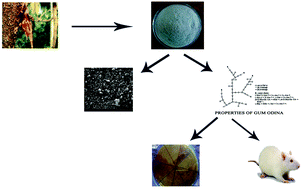Prebiotic potential of gum odina and its impact on gut ecology: in vitro and in vivo assessments
Abstract
The use of prebiotics to escalate certain gut flora is a current aspect of research for effective gut ecology. In the present study we appraise the efficacy of gum odina obtained from the bark of Odina wodier (Anacardiaceae), which is not fully degraded (16%) in the upper GI tract and becomes available to the lower region, as a prebiotic. An in vitro prebiotic activity assay established a quantitative score to describe the extent to which gum odina supports the selective growth of probiotics with a maximum of 5.60 ± 0.11 for Lactobacillus plantarum MTCC 6160. The polysaccharide, upon fermentation, also liberates lactic acid (0.46 ± 0.003 mg ml−1) and acetic acid (1.03 ± 0.003 mg ml−1). In vivo studies revealed that natural gum selectively stimulates Lactobacillus sp., and eliminates enteric pathogens with a C.F.U. of 384.48 ± 0.11 and 40.56 ± 0.17 respectively on the 8th day. The changes in the level of β-galactosidase signify maturation of macrophages in the gut environment. It also boosts the immune system by increasing sIgA upon infection from the 5th day in the gut, when incorporated into the feed of mice. Moreover an increase in levels of IFNγ on the 5th day also manifest additional protection against various pathogen-induced primary and secondary infections. Thus, gum odina is a potential prebiotic which not only provides nutrition but also improves gut ecology.

- This article is part of the themed collection: Probiotics, Prebiotics and Gut Health

 Please wait while we load your content...
Please wait while we load your content...